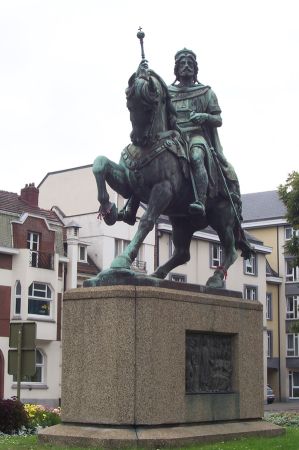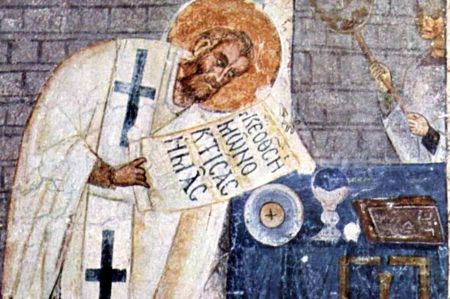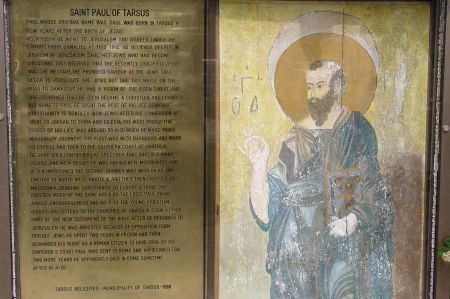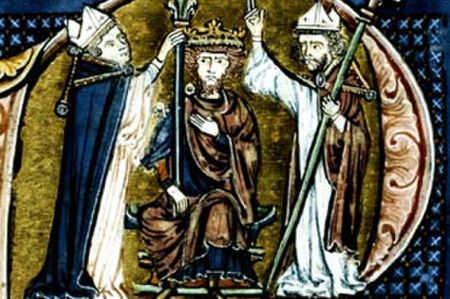Baldwin I - First Crusade and King of Jerusalem
- Written by Portal Editor
Baldwin of Boulogne was the second youngest son of Eustace II, Count of Boulogne and his wife Ida of Lorraine. He was born in 1058, the exact date is unclear. Balduin worked as a canon in the city of Reims until 1086, a loyal cleric of the cathedral chapter, which he only left because the church reform no longer permitted accumulation of benefices.
He then lived in Normandy until his first marriage to Godehilde, daughter of Raoul II de Tosny. Later, after his return to Lorraine, he took over the county of Verdun from his brother Gottfried.
In 1096 Baldwin embarked on the First Crusade to the Holy Land together with his brother Gottfried and his wife Godehilde. To finance the crusade he had sold large parts of his lands to the church. While his crusader army was marching through Hungary, Baldwin had given himself up as a hostage into the hands of King Koloman, who feared that the crusaders would plunder Hungary. Balduin and Gottfried marched together as far as Heraclea in Asia Minor. From Heraclea, Baldwin marched on to Cilicia together with Tancred, probably in order to establish himself as a regional ruler. From historical records we know today that this was at least the firm intention of Tancred.
Baldwin was the absolute ruler of Edessa
 Tancred was already the ruler of Tarsus when, in September 1097, Baldwin reached Tarsus and took over the dominion of Tancred. With the help of a pirate fleet sailing from Boulogne to Tarsus, Baldwin established his own garrison. After attacks against Mamistra, which led to no success without open war, Balduin and Tancred turned against Antioch. In Marasch, Balduin's troops met the main army of the crusaders again and Balduin also found out about the death of his wife Godehilde, which means that his inheritance claim to the lands of his father-in-law were also extinguished.
Tancred was already the ruler of Tarsus when, in September 1097, Baldwin reached Tarsus and took over the dominion of Tancred. With the help of a pirate fleet sailing from Boulogne to Tarsus, Baldwin established his own garrison. After attacks against Mamistra, which led to no success without open war, Balduin and Tancred turned against Antioch. In Marasch, Balduin's troops met the main army of the crusaders again and Balduin also found out about the death of his wife Godehilde, which means that his inheritance claim to the lands of his father-in-law were also extinguished.
At the invitation of the Armenian Pakrad, Baldwin marched east to the Euphrates and was able to occupy the Turbessel fortress. Only a little later was an invitation to Edessa to the local ruler Thoros, who adopted him as his son and successor. With the murder of Thoros, to this day there is disagreement as to whether Balduin had a hand in this, he took power on March 10, 1098 and was proclaimed Count of Edessa.
Until 1100, Baldwin was the absolute ruler of Edessa, married the daughter of the Armenian prince Taphnuz named Orianta from Melitene, and subsequently often acted as a mediator between the interests of the Armenians and the Crusaders. Little loved by the inhabitants of Edessa, Balduin had to constantly protect and defend himself against attacks, so that he never left the house without full armor and an escort. As a punitive action, he captured leading citizens of the city of Edessa and had them cruelly tortured and then banished. In the years he conquered Samosata and Seruj and together with Bohemond of Taranto he visited Jerusalem, which had meanwhile been conquered by the main army of the crusaders. With this visit Baldwin had finally fulfilled his crusade vows and so he returned to Edessa in January 1100.
Baldwin was also able to conquer the cities of Arsuf and Caesarea
 Meanwhile, his brother Gottfried had risen as "Protector of the Holy Sepulcher" to ruler of the secular kingdom of Jerusalem that was now established. With the death of his childless brother, Baldwin was ordered back to Jerusalem in July 1100 and was crowned the first king of Jerusalem on Christmas Day 1100 by Daimbert of Pisa, the Latin Patriarch of Jerusalem. Meanwhile Balduin's cousin, Balduin von Bourcq, had taken over the county of Edessa.
Meanwhile, his brother Gottfried had risen as "Protector of the Holy Sepulcher" to ruler of the secular kingdom of Jerusalem that was now established. With the death of his childless brother, Baldwin was ordered back to Jerusalem in July 1100 and was crowned the first king of Jerusalem on Christmas Day 1100 by Daimbert of Pisa, the Latin Patriarch of Jerusalem. Meanwhile Balduin's cousin, Balduin von Bourcq, had taken over the county of Edessa.
With the consolidation of his power in Jerusalem, Baldwin also began to extend his policy of expansion to other cities. He found support for this above all from the Italian trading cities, especially Genoa, which subsequently delivered war materials and siege machines from the sea and in return received trading offices in the conquered cities.
The attacks by the Fatimid dynasty from Egypt that followed in the next few years were successfully repelled by Baldwin until 1105, when he himself counterattacked in 1115. In this way he was able to gain access to the Red Sea and strengthened access by building Fort Montreal. Balduin was also able to conquer the cities of Arsuf and Caesarea in the north with the help of Venice and the Norwegian king Sigurd I, which meant that Damascus lost its access to the Mediterranean.
 These military successes brought Baldwin nominal supremacy over other Christian rulers in the County of Tripoli, the Principality of Atiochia and also the County of Edessa. Baldwin had also paid the ransom for Bohemond I of Antioch when he was taken prisoner after a battle in 1103. Thus he had become the arbitrator of the barons outside the walls of Tripoli, forcing Tancred to relinquish his claims to the city. With that, Tripoli also fell to the Crusaders and became a vassal state of the king of Jerusalem.
These military successes brought Baldwin nominal supremacy over other Christian rulers in the County of Tripoli, the Principality of Atiochia and also the County of Edessa. Baldwin had also paid the ransom for Bohemond I of Antioch when he was taken prisoner after a battle in 1103. Thus he had become the arbitrator of the barons outside the walls of Tripoli, forcing Tancred to relinquish his claims to the city. With that, Tripoli also fell to the Crusaders and became a vassal state of the king of Jerusalem.
Baldwin marries a third time. Now it was Adelheit, the daughter of Margrave Manfred von Savona. When he died of fish poisoning in al-Arish on April 2, 1118, while returning from a campaign in Egypt that had brought him to the Nile, he was buried in the Church of the Holy Sepulcher in Jerusalem because of his activities for Christianity. His cousin Balduin von Bourcq, who had already followed him in Edessa, succeeded him.
Please read as well:
